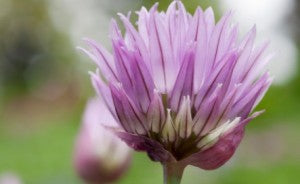42 Flowers You Can Eat
 The culinary use of flowers dates back thousands of years to the Chinese, Greek and Romans. Many cultures use flowers in their traditional cooking--think of squash blossoms in Italian food and rose petals in Indian food. Adding flowers to your food can be a nice way to add color, flavor, and a little whimsy. Some are spicy, and some herbacious, while others are floral and fragrant. The range is pretty surprising.
It's not uncommon to see flower petals used in salads, teas, and as garnish for desserts, but they inspire creative uses as well--roll spicy ones (like chive blossoms) into handmade pasta dough, incorporate floral ones into homemade ice cream, pickle flower buds (like nasturtium) to make ersatz capers, use them to make a floral simple syrup for use in lemonade or cocktails. (See a recipe for Dandelion Syrup here.) I once stuffed gladiolus following a recipe for stuffed squash blossoms--a little out-there, I know, but they were great. So many possibilities...
Eating Flowers Safely
So. As lovely as eating flowers can be, it can also be a little...deadly! Not to scare you off or anything. Follow these tips for eating flowers safely.
The culinary use of flowers dates back thousands of years to the Chinese, Greek and Romans. Many cultures use flowers in their traditional cooking--think of squash blossoms in Italian food and rose petals in Indian food. Adding flowers to your food can be a nice way to add color, flavor, and a little whimsy. Some are spicy, and some herbacious, while others are floral and fragrant. The range is pretty surprising.
It's not uncommon to see flower petals used in salads, teas, and as garnish for desserts, but they inspire creative uses as well--roll spicy ones (like chive blossoms) into handmade pasta dough, incorporate floral ones into homemade ice cream, pickle flower buds (like nasturtium) to make ersatz capers, use them to make a floral simple syrup for use in lemonade or cocktails. (See a recipe for Dandelion Syrup here.) I once stuffed gladiolus following a recipe for stuffed squash blossoms--a little out-there, I know, but they were great. So many possibilities...
Eating Flowers Safely
So. As lovely as eating flowers can be, it can also be a little...deadly! Not to scare you off or anything. Follow these tips for eating flowers safely.
- Eat flowers you know to be consumable--if you are uncertain, consult a reference book on edible flowers and plants.
- Eat flowers you have grown yourself, or know to be safe for consumption. Flowers from the florist or nursery have probably been treated with pesticide or other chemicals.
- Do not eat roadside flowers or those picked in public parks. Both may have been treated with pesticide or herbicide, and roadside flowers may be polluted by car exhaust
- Eat just the petals, and remove pistils and stamens before eating.
- If you suffer from allergies, introduce edible flowers gradually, as they may exacerbate allergies.
- To keep flowers fresh, place them on moist paper towels and refrigerate in an airtight container. Some will last up to 10 days this way. Ice water can revitalize limp flowers.
